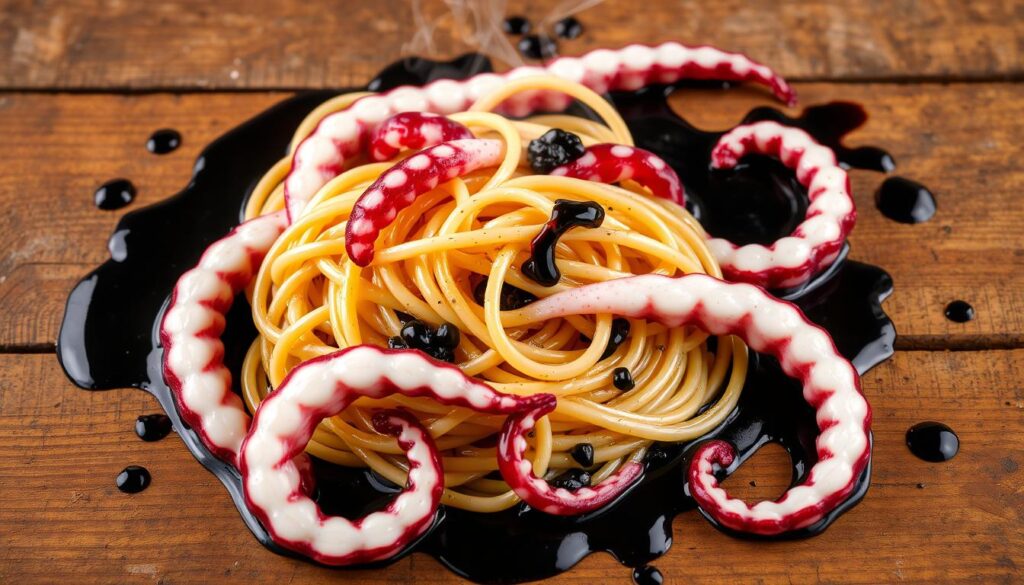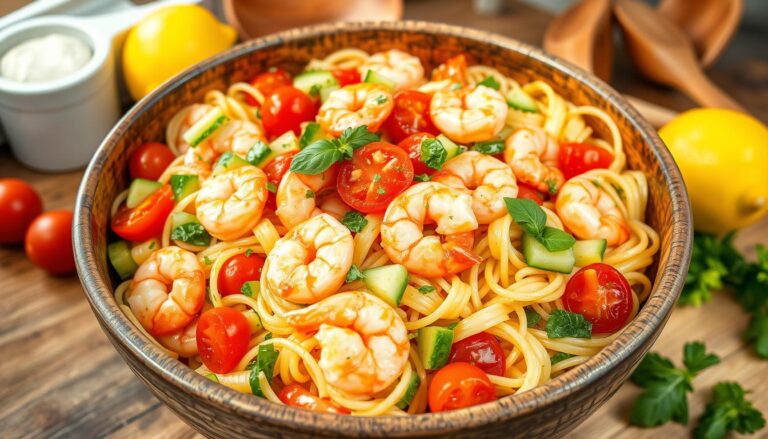Squid Ink Seafood Pasta: A Gourmet Delight You’ll Love
If you’ve ever eaten at a seaside restaurant, you know the joy of fresh seafood. The ocean breeze makes it even better. Black squid ink pasta takes this joy to a new level. It combines the ocean’s taste with a stunning look that excites your taste buds.
This dish is more than food; it’s a journey through the sea’s stories. It’s perfect for those who love gourmet seafood recipes that amaze.
Exploring squid ink pasta reveals endless culinary wonders. You’ll learn about its rich history and unique taste. Plus, you’ll discover how to make this luxurious dish at home. Are you ready to make your meals more magical with squid ink?
Table of Contents
What is Squid Ink Seafood Pasta?
Squid ink seafood pasta is a mix of creativity and traditional tastes. It has a black color from squid ink and a briny flavor. This makes any dish stand out.
This ingredient comes from squids and cuttlefish. It’s used in the pasta dough or sauce. It’s a key part of many seafood pasta dishes.
It’s loved in Mediterranean cuisine, like in Italian coastal areas. Squid ink pasta is a favorite on menus everywhere.
Making this dish is quick, taking about 30 minutes. It cooks in just 15 minutes. With the right ingredients, your dish will taste like a fancy restaurant’s.
For more recipes and tips, check out this resource.
Whether for a dinner party or a special meal, squid ink pasta will wow your guests.
The Rich History of Squid Ink in Culinary Tradition
The history of squid ink goes back centuries, mainly in Mediterranean cultures. It’s a key part of culinary traditions. Spanish and Italian chefs often use it in dishes like paella and risotto. Its unique taste and deep black color make meals more appealing.
At first, squid ink was seen as a local treasure. But now, it’s loved worldwide. Its use in seafood dishes shows a deep connection to local ingredients. For example, it’s used in Calamarata pasta, celebrating the ocean’s flavors.
Learning about squid ink’s history shows its importance in global cuisine. It’s known for its cultural value and taste. With over 350 pasta shapes in Italy, squid ink pairs well with seafood. This combination brings out traditional flavors and encourages new recipes.
Benefits of Using Squid Ink in Your Pasta Dishes
Adding squid ink to your pasta dishes brings many benefits. It not only makes the flavors better but also adds healthy nutrients. These nutrients help make your diet more balanced.
Nutritional Value of Squid Ink
Squid ink is packed with important nutrients. It has 15-18 grams of protein per serving, which is great for your health. Squid is also low in calories and fat, helping with weight control.
It’s a good source of vitamin B-12, which is key for your brain and blood cells. Squid has low mercury levels, so you can enjoy it without worry. It has all nine essential amino acids, making it a complete protein.
Squid is also rich in potassium and omega-3 fatty acids. These can help lower blood pressure and support heart health. These benefits show why squid ink is so good for you.
Unique Flavor Profile
The taste of squid ink is rich and unique. It adds a briny, slightly sweet flavor to pasta dishes. This creates a deep, umami taste that makes your meals better.
Using squid ink with seafood adds complexity to your dishes. Its distinct flavor makes it great for many recipes. For more ideas, check out creative uses of canned red salmon.
How to Prepare Squid Ink Seafood Pasta
Learning how to make squid ink pasta is a journey to a unique dining experience. It combines squid ink’s rich flavor with seafood, making any meal special. The right ingredients and cooking methods are key to making this dish.
Essential Ingredients
For a great squid ink seafood pasta, you’ll need these ingredients:
- 12 oz squid ink pasta
- 3 Tbsp olive oil
- 2 Tbsp butter
- ½ Tbsp minced garlic (approximately 2 cloves)
- ¼ tsp red pepper flakes
- ¾ cup dry white wine or chicken broth
- Zest and juice of 1 lemon (around 6 Tbsp of fresh lemon juice)
- 1 can of La Barca Squid in Ink
- 2 oz freshly grated parmesan cheese
- Chopped fresh parsley for garnish (optional)
Step-by-Step Cooking Instructions
Cooking squid ink seafood pasta is simple yet effective. Follow these steps to make your dish:
- Cook the squid ink pasta as directed until it’s al dente. Save some pasta water for later.
- In a big pan, heat olive oil over medium heat. Add garlic and red pepper flakes, sauté for 30 seconds until fragrant.
- Add the La Barca squid in ink, letting the flavors mix for a couple of minutes.
- Pour in the white wine or chicken broth, letting it reduce by half to intensify the flavor.
- Gently toss the cooked squid ink pasta in the pan, ensuring it’s well coated with the sauce. If the sauce is too thick, add a bit of pasta water.
- Finish with fresh lemon juice and zest, adding a zesty contrast. Serve with parmesan cheese and parsley.
For more tips and recipes, check out this comprehensive guide. With these steps, cooking squid ink seafood pasta becomes a culinary adventure that will please your taste buds.

Squid Ink Seafood Pasta Recipe: A Simple and Flavorful Approach
Try an easy squid ink pasta dish that’s both tasty and beautiful. This recipe is simple, great for beginners or pros. It combines fresh seafood with squid ink for a unique taste.
| Ingredient | Quantity |
|---|---|
| Squid ink pasta | 12 oz |
| Squid (cleaned, sliced into rings) | 8 oz |
| Large shrimp (peeled, deveined) | 8 |
| Scallops | 8 |
| Extra virgin olive oil | 4 tablespoons |
| Garlic (minced) | 4 cloves |
| White wine | 1/2 cup |
| Red pepper flakes | 1/2 teaspoon |
| Fish stock or clam juice | 1 cup |
| Cherry tomatoes (halved) | 1 cup |
| Unsalted butter | 1 tablespoon |
This recipe makes four servings and takes 50 minutes to make. Start by boiling water with salt. Then, add the pasta and cook for 3-4 minutes for the right texture.
In another pan, heat olive oil and sauté garlic for a minute. Add shrimp and scallops, cooking for 2-3 minutes on each side. Then, add squid and cook for 1-2 minutes on each side.
Pour in white wine and let it simmer until it reduces a bit. Mix in fish stock or clam juice and cherry tomatoes. Let the sauce simmer for three minutes.
Combine the pasta with seafood, adding pasta water if needed. Finish with unsalted butter for richness. Your dish is now ready to serve.
This easy squid ink pasta dish is impressive with its seafood and squid ink. Add fresh herbs and olive oil for a great finish.
Alternative Ingredients for Squid Ink Pasta
Looking for squid ink pasta alternatives can spark your creativity in the kitchen. You might want to make a dish that captures the essence of squid ink without using it. There are many seafood substitutes, making it easy to create squid ink pasta variations for different tastes.
Substitutes for Squid Ink
Can’t find squid ink? Dried black beans can make a vegan version that looks great. Making pasta from black beans is similar to chickpea pasta dough, giving it a similar feel. Black beans offer a neutral taste that goes well with sauces, unlike squid ink’s unique flavor.
Activated charcoal is also a popular choice for its coloring in cooking. It’s known for its ability to add a dark color to dishes.
Variations in Seafood Choices
Adding different seafood to your dish can make it more exciting. Try using shrimp, mussels, or clams with squid. This not only adds flavor but also supports sustainable eating.
Plant-based seafood options like king oyster mushrooms or hearts of palm can also work well. Adding seaweed powder to sauces can mimic seafood tastes, making vegan dishes just as tasty.

For more creative ideas, check out this collection of mixed seafood recipes. It showcases both traditional and alternative ingredients in pasta dishes.
Popular Squid Ink Pasta Dishes Around the World
Exploring squid ink pasta takes you on a journey through famous squid ink dishes from around the world. These dishes are special because they highlight the deep, rich flavors squid ink adds.
In Italy, Spaghetti al Nero di Seppia is a favorite. It’s made with squid ink, giving the pasta a dark, rich color. This dish is a hit with those who love authentic Italian food. It shows how squid is a big part of Italian global seafood recipes. In fact, about 75% of Italian seafood pasta recipes use squid.
Spain has its own version, Arroz Negro, a squid ink rice dish that’s loved worldwide. It’s a great example of how squid ink is used in different cuisines. Making squid ink pasta dishes usually takes about 30 minutes, so you can enjoy a fancy meal quickly.
Let’s look at the nutritional values of these dishes:
| Dish | Calories per Serving | Carbohydrates (g) | Protein (g) | Fat (g) | Sodium (mg) |
|---|---|---|---|---|---|
| Squid Ink Pasta | 617 | 68 | 16 | 21 | 456 |
| Spaghetti al Nero di Seppia | 464 | 51 | 25 | 18 | 150 |
| Arroz Negro | N/A | N/A | N/A | N/A | N/A |
Also, calamari pasta is great for parties because it makes four servings. When making these global seafood recipes, use fresh ingredients like lemon juice, garlic, and white wine. They enhance the squid ink’s unique taste.
Pairing Suggestions for Your Squid Ink Pasta
When you serve squid ink pasta, known as pasta al nero di seppia, the choice of pairings enhances the overall dining experience. To elevate the flavors of this unique dish, consider a few key suggestions.
For wine and seafood pairings, white wines emerge as top contenders. A crisp Sauvignon Blanc or a dry Italian Verdicchio complements the briny notes of the squid ink beautifully. These selections balance the dish’s flavor profile, enriching your meal with refreshing acidity.
As for the best sides for squid ink, light and invigorating options work well. A fresh green salad adorned with a citrus dressing adds a zesty contrast to the pasta’s rich taste. Warm garlic bread also serves as a delightful accompaniment, allowing diners to soak up any leftover sauce.

| Wine Pairings | Side Dishes |
|---|---|
| Sauvignon Blanc | Citrus Salad |
| Dry Italian Verdicchio | Garlic Bread |
These pairings for squid ink pasta not only highlight the unique flavors of the dish but also provide contrasting tastes that enhance your culinary experience.
Squid Ink Seafood Pasta: A Perfect Dish for Occasions
For special occasions seafood dishes, squid ink pasta is a top pick. Its dark color adds a touch of elegance, perfect for romantic dinners or big gatherings.
This dish impresses with its mix of ingredients, like aged chorizo and live cockles. It’s easy to make, ready in just 30 minutes. This makes it great for both new and seasoned cooks.
It’s perfect for gourmet pasta for events, serving four or six with a salad. The seafood and lemon juice blend beautifully. It’s a hit for any celebration or cozy dinner.
Imagine serving a homemade dish that wows your guests. It’s filled with seafood and rice for a rich taste. Each serving is a highlight at any event.
The dish uses garlic, white wine, and tomato puree for depth. With 858 calories per serving, it’s both tasty and nutritious.
| Ingredient | Quantity |
|---|---|
| Aged Chorizo | 3 ounces |
| Live Cockles | 24 |
| Fresh Squid Ink Pasta | 2/3 lb (Fettucine) |
| Chicken/Vegetable/Fish Stock | 1 cup |
| Dry White Wine | ½ cup |
| Garlic | 4 cloves |
| Lemon Juice | 1 lemon |
| Tomato Puree | 1 cup |
| Cooking time for Pasta | 8-10 minutes |
| Cooking time for Shrimp | 3-4 minutes per side |
| Serving Size | 4 people |
| Calories per Serving | 858 kcal |
This squid ink pasta is more than a meal; it’s a statement for squid ink for gatherings. Its flavors and presentation make it unforgettable.
Storing and Reheating Squid Ink Seafood Pasta
Wondering how to store and reheat squid ink seafood pasta? It’s important to keep it fresh and safe. Here are some tips to help you enjoy your leftovers.
Best Practices for Leftovers
To keep your squid ink pasta tasty, follow these steps:
- Put leftovers in an airtight container within two hours to avoid spoilage.
- Refrigerated pasta stays good for up to three days if sealed well.
- Freezing extends storage to up to three months.
- Reheat with olive oil in a skillet to add moisture.
- Use the microwave for quick reheating. Stir between intervals for even heating.
Here’s a quick guide for storing and reheating squid ink pasta:
| Storage Method | Duration | Reheating Method | Time |
|---|---|---|---|
| Refrigerator | Up to 3 days | Skillet | 5-10 minutes |
| Freezer | Up to 3 months | Microwave | 2-3 minutes |
By using these leftover squid ink tips, your pasta will stay delicious and safe. Proper storage and reheating make your meal even better.
Conclusion
Exploring the world of food, squid ink seafood pasta is a must-try. It blends history with modern tastes, offering stunning looks and unique flavors. Seafood is a big hit in fancy dining, making this pasta perfect for parties and celebrations.
Adding squid ink pasta to your menu makes your meal stand out. You can stick to classic recipes or add your own twist. This dish is a hit with those who love trying new seafood, making your meals memorable.
Trying squid ink pasta connects you to a rich culinary tradition. It’s gaining popularity, showing people are eager to explore new seafood dishes. For more ideas, check out this squid ink pasta recipe or discover more seafood recipes for your next meal.
FAQ
What is squid ink seafood pasta?
What are the nutritional benefits of squid ink?
Can I use substitutes for squid ink in recipes?
What seafood can I use with squid ink pasta?
How should I store leftover squid ink seafood pasta?
What wine pairs well with squid ink seafood pasta?
Is squid ink pasta suitable for special occasions?
Where did squid ink dishes originate?
Squid Ink Seafood Pasta: A Gourmet Delight You’ll Love
If you’re a seafood lover looking for a dish that’s both elegant and flavorful, Squid Ink Seafood Pasta is a must-try! This gourmet dish brings together the rich, briny taste of the ocean with the silky, slightly salty essence of squid ink, creating a truly unique dining experience.







